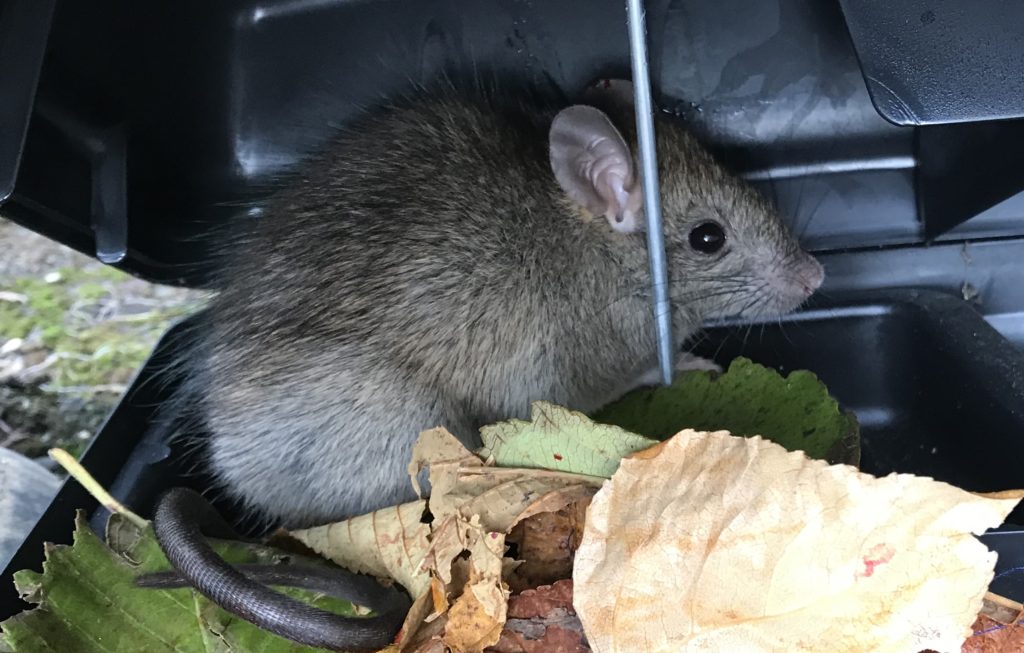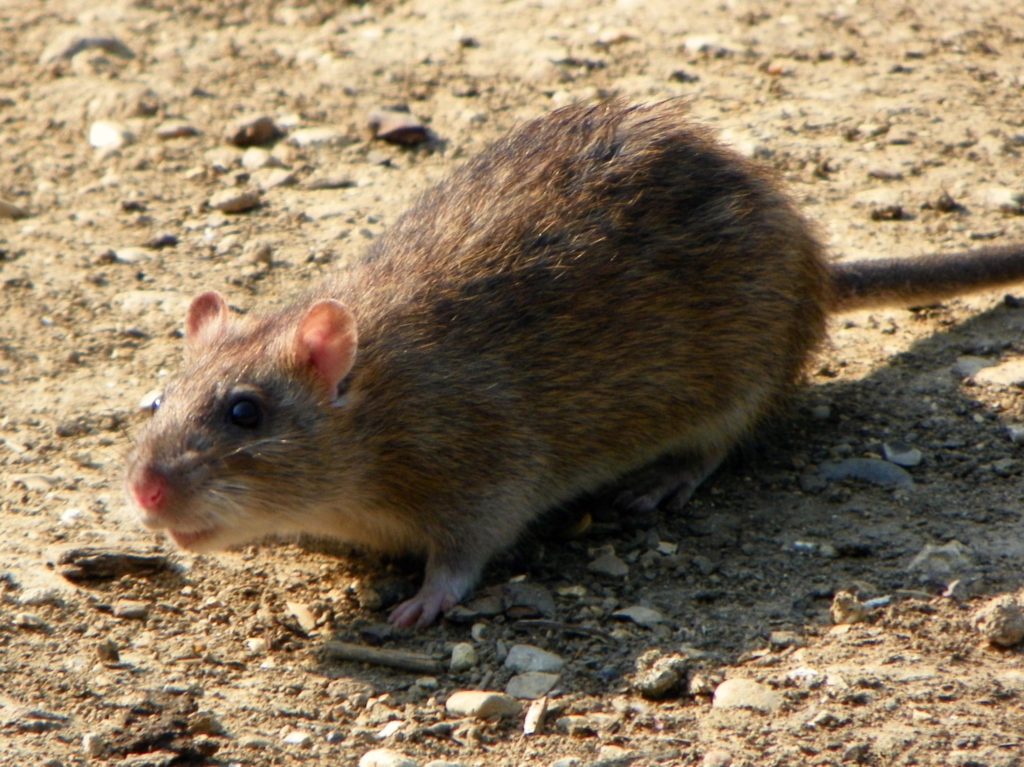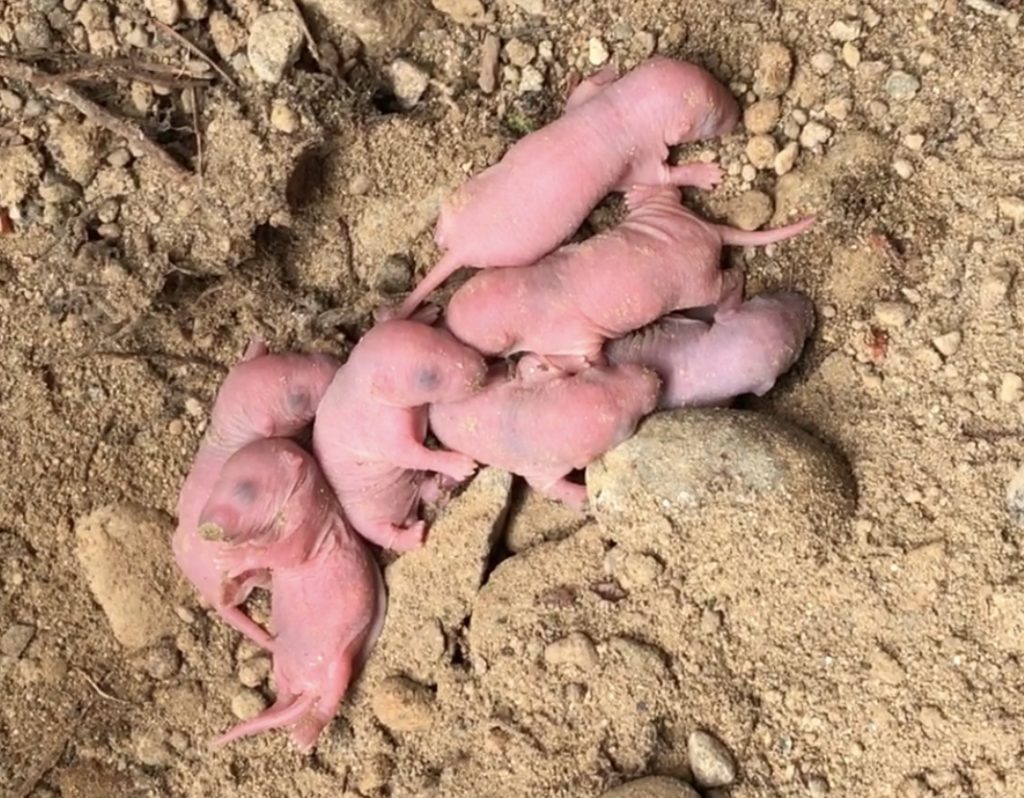
Roof Rat
The black rat , also known as the ship rat, roof rat, house rat, is a common long-tailed rodent of the genus Rattus (rats) in the subfamily Murinae.
Black rats are considered omnivores and eat a wide range of foods, including seeds, fruit, stems, leaves, fungi, and a variety of invertebrates and vertebrates. They are generalists, and thus not very specific in their food preferences, which is indicated by their tendency to feed on any meal provided for cows, swine, chickens, cats, and dogs. They are similar to the tree squirrel in their preference of fruits and nuts. They eat about 15 grams (0.53 oz) per day and drink about 15 milliliters (0.53 imp fl oz; 0.51 US fl oz) per day. Their diet is high in water content. They are a threat to many natural habitats because they feed on birds and insects. They are also a threat to many farmers, since they feed on a variety of agricultural-based crops, such as cereals, sugar cane, coconuts, cocoa, oranges, and coffee beans.

Roof Rat
The black rat , also known as the ship rat, roof rat, house rat, is a common long-tailed rodent of the genus Rattus (rats) in the subfamily Murinae.
Black rats are considered omnivores and eat a wide range of foods, including seeds, fruit, stems, leaves, fungi, and a variety of invertebrates and vertebrates. They are generalists, and thus not very specific in their food preferences, which is indicated by their tendency to feed on any meal provided for cows, swine, chickens, cats, and dogs. They are similar to the tree squirrel in their preference of fruits and nuts. They eat about 15 grams (0.53 oz) per day and drink about 15 milliliters (0.53 imp fl oz; 0.51 US fl oz) per day. Their diet is high in water content. They are a threat to many natural habitats because they feed on birds and insects. They are also a threat to many farmers, since they feed on a variety of agricultural-based crops, such as cereals, sugar cane, coconuts, cocoa, oranges, and coffee beans.
Norway Rat
The brown rat is nocturnal and is a good swimmer, both on the surface and underwater, and has been observed climbing slim round metal poles several feet in order to reach garden bird feeders. Brown rats dig well, and often excavate extensive burrow systems. A 2007 study found brown rats to possess metacognition, a mental ability previously only found in humans and some primates, but further analysis suggested they may have been following simple operant conditioning principles.
The Brown rat, also referred to as common rat, street rat, sewer rat, Hanover rat, Norway rat, Norwegian rat, or wharf rat (Rattus norvegicus) is one of the best known and most common rats. One of the largest muroids, it is a brown or grey rodent with a body up to 25 cm (10 in) long, and a similar tail length; the male weighs on average 350 g (12 oz) and the female 250 g (9 oz). Thought to have originated in northern China, this rodent has now spread to all continents except Antarctica, and is the dominant rat in Europe and much of North America—making it by at least this particular definition the most successful mammal on the planet alongside humans. With rare exceptions, the brown rat lives wherever humans live, particularly in urban areas.


Norway Rat
The brown rat is nocturnal and is a good swimmer, both on the surface and underwater, and has been observed climbing slim round metal poles several feet in order to reach garden bird feeders. Brown rats dig well, and often excavate extensive burrow systems. A 2007 study found brown rats to possess metacognition, a mental ability previously only found in humans and some primates, but further analysis suggested they may have been following simple operant conditioning principles.
The Brown rat, also referred to as common rat, street rat, sewer rat, Hanover rat, Norway rat, Norwegian rat, or wharf rat (Rattus norvegicus) is one of the best known and most common rats. One of the largest muroids, it is a brown or grey rodent with a body up to 25 cm (10 in) long, and a similar tail length; the male weighs on average 350 g (12 oz) and the female 250 g (9 oz). Thought to have originated in northern China, this rodent has now spread to all continents except Antarctica, and is the dominant rat in Europe and much of North America—making it by at least this particular definition the most successful mammal on the planet alongside humans. With rare exceptions, the brown rat lives wherever humans live, particularly in urban areas.

House Mouse
The house mouse (Mus musculus) is a small mammal of the order Rodentia, characteristically having a pointed snout, small rounded ears, and a long naked or almost hairless tail. It is one of the most numerous species of the genus Mus. Although a Wild animal, the house mouse mainly lives in association with humans.
House mice have an adult body length (nose to base of tail) of 7.5–10 cm (3.0–3.9 in) and a tail length of 5–10 cm (2.0–3.9 in). The weight is typically 40–45 g (1.4–1.6 oz). In the wild they vary in colour from light to dark, (light to dark brown), but domesticated fancy mice and laboratory mice are produced in many colors ranging from white to champagne to black.They have short hair and some, but not all, sub-species have a light belly. The ears and tail have little hair. The hind feet are short compared to Apodemus mice, only 15–19 mm (0.59–0.75 in) long; the normal gait is a run with a stride of about 4.5 cm (1.8 in), though they can jump vertically up to 45 cm (18 in). The voice is a high-pitched squeak. House mice thrive under a variety of conditions; they are found in and around homes and commercial structures, as well as in open fields and agricultural lands. House mice usually run, walk, or stand on all fours, but when eating, fighting, or orienting themselves, they rear up on their hind legs with additional support from the tail - a behavior known as "tripoding". Mice are good jumpers, climbers, and swimmers, usually attempts to maintain contact with vertical surfaces.

House Mouse
The house mouse (Mus musculus) is a small mammal of the order Rodentia, characteristically having a pointed snout, small rounded ears, and a long naked or almost hairless tail. It is one of the most numerous species of the genus Mus. Although a Wild animal, the house mouse mainly lives in association with humans.
House mice have an adult body length (nose to base of tail) of 7.5–10 cm (3.0–3.9 in) and a tail length of 5–10 cm (2.0–3.9 in). The weight is typically 40–45 g (1.4–1.6 oz). In the wild they vary in colour from light to dark, (light to dark brown), but domesticated fancy mice and laboratory mice are produced in many colors ranging from white to champagne to black.They have short hair and some, but not all, sub-species have a light belly. The ears and tail have little hair. The hind feet are short compared to Apodemus mice, only 15–19 mm (0.59–0.75 in) long; the normal gait is a run with a stride of about 4.5 cm (1.8 in), though they can jump vertically up to 45 cm (18 in). The voice is a high-pitched squeak. House mice thrive under a variety of conditions; they are found in and around homes and commercial structures, as well as in open fields and agricultural lands. House mice usually run, walk, or stand on all fours, but when eating, fighting, or orienting themselves, they rear up on their hind legs with additional support from the tail - a behavior known as "tripoding". Mice are good jumpers, climbers, and swimmers, usually attempts to maintain contact with vertical surfaces.